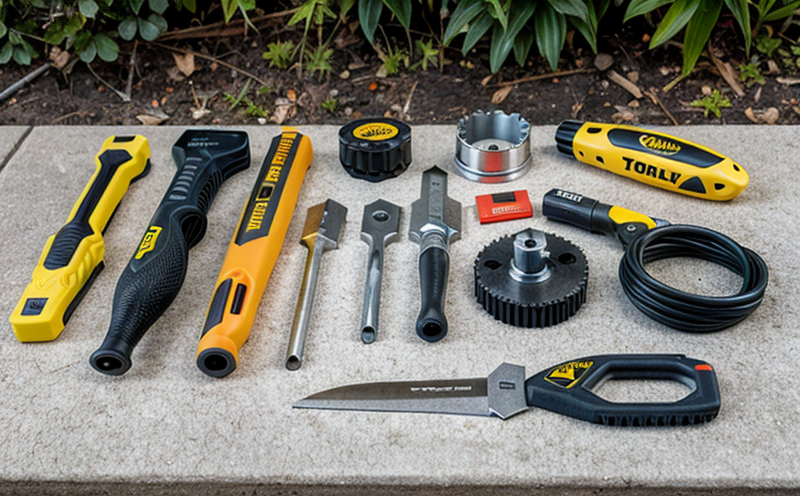Rust Resistance Testing of DIY Tools
The durability and longevity of DIY tools are crucial factors in their performance and user satisfaction. Rust resistance testing ensures that the materials used in these tools can withstand environmental conditions, which is particularly important for outdoor projects or tools stored in humid environments.
Rust resistance testing typically involves exposing specimens to controlled environments designed to mimic real-world conditions where rust may form. This process helps manufacturers and quality assurance teams identify any weaknesses in the tool materials early on, allowing them to make necessary adjustments before products reach the market.
In this testing procedure, tools are subjected to various environmental stressors such as salt spray, humidity, and temperature fluctuations. The duration of exposure can vary depending on the specific requirements set by industry standards or customer expectations. For example, ASTM B117 is often used for salt spray testing, while ISO 9227 provides guidelines for immersion tests.
Once exposed to these conditions, the specimens are inspected for signs of rust formation using visual inspection methods. In some cases, more advanced techniques like X-ray fluorescence (XRF) or energy-dispersive spectroscopy (EDS) may be employed to analyze the surface composition and identify early stages of corrosion.
Acceptance criteria play a vital role in determining whether the tested materials meet the necessary standards. Typically, these criteria specify maximum allowable amounts of rust or pitting on the surface after exposure. Compliance with such limits ensures that consumers receive reliable products free from significant degradation issues.
- Visual Inspection: A basic method to detect rust formation during testing.
- XRF/EDS Analysis: Advanced techniques used for deeper analysis of surface composition changes due to corrosion.
- Environmental Exposure Conditions: Controlled salt spray, humidity levels, and temperature variations simulate real-world conditions.
The importance of rust resistance testing cannot be overstated in the context of DIY tools. By incorporating this critical step into their development processes, manufacturers can enhance product quality, extend tool life, and ultimately improve customer satisfaction. This not only enhances brand reputation but also fosters trust among users who rely heavily on these products for various home improvement tasks.
For those involved in the testing process—from R&D engineers to compliance officers—understanding the intricacies of rust resistance testing is essential. It provides valuable insights into material selection, design considerations, and potential improvements that could lead to more robust DIY tools. Furthermore, compliance with relevant international standards such as ASTM B117 or ISO 9227 ensures consistency across markets while meeting regulatory requirements.
In summary, rust resistance testing is a cornerstone of quality assurance in the manufacturing of DIY tools. Through rigorous exposure and inspection methods, manufacturers can ensure that their products remain reliable and effective under harsh conditions, thereby delivering superior value to end-users.
Industry Applications
In the consumer products sector, particularly within DIY tools & hardware, rust resistance testing is essential for ensuring product longevity. This service supports several key areas:
- R&D Engineers: They rely on this testing to optimize material choices and design iterations.
- Quality Managers: It helps them maintain consistent quality standards across production batches.
- Compliance Officers: Ensures adherence to industry regulations and customer expectations regarding durability.
The results of these tests are crucial for several reasons:
- Enhanced Durability: By identifying weak points early, manufacturers can improve overall product performance.
- Informed Decision-Making: Data from rust resistance testing informs strategic decisions about material sourcing and manufacturing processes.
- Risk Mitigation: Early detection of potential issues reduces the likelihood of costly recalls or brand damage.
Quality and Reliability Assurance
Ensuring the quality and reliability of DIY tools is paramount, especially when it comes to rust resistance. Here are some key aspects that contribute to this:
- Consistent Exposure Conditions: Controlled environments like salt spray chambers provide uniform exposure.
- Data Analysis: Advanced analytical tools help quantify changes in material properties over time.
- User Feedback: Incorporating user feedback can guide further improvements based on real-world performance data.
The importance of these factors lies in their ability to provide actionable insights that drive continuous improvement within the manufacturing process. By adhering to strict protocols and leveraging modern testing technologies, companies can achieve higher levels of product reliability.
Use Cases and Application Examples
Rust resistance testing finds application in numerous scenarios where DIY tools are used:
- Outdoor Projects: Tools like hammers, screwdrivers, and wrenches exposed to elements need robust rust resistance.
- Storage Conditions: Humid storage environments demand materials capable of withstanding moisture without corroding.
- High-Use Applications: Power tools that are frequently handled or operated in demanding conditions require superior durability.
For instance, a manufacturer might test a new line of outdoor-rated screwdrivers to ensure they can withstand exposure to saltwater during coastal construction projects. Another example would be evaluating the longevity of ratchet wrenches used by professionals who work in harsh weather conditions.
These tests not only enhance product reliability but also contribute significantly to customer satisfaction, which is critical for any company aiming to establish a strong market presence in the DIY tools industry.





